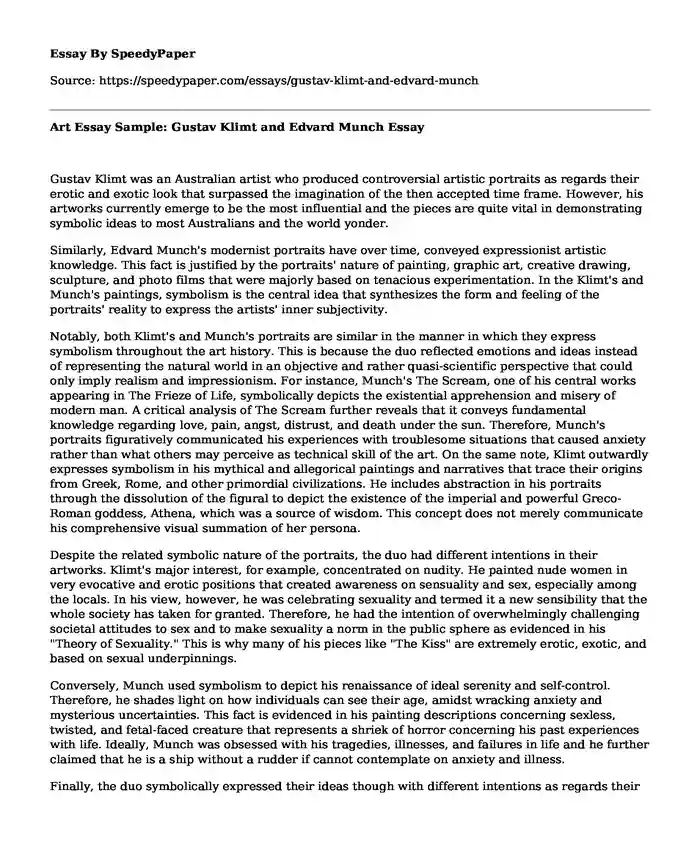Gustav Klimt was an Australian artist who produced controversial artistic portraits as regards their erotic and exotic look that surpassed the imagination of the then accepted time frame. However, his artworks currently emerge to be the most influential and the pieces are quite vital in demonstrating symbolic ideas to most Australians and the world yonder.
Similarly, Edvard Munch's modernist portraits have over time, conveyed expressionist artistic knowledge. This fact is justified by the portraits' nature of painting, graphic art, creative drawing, sculpture, and photo films that were majorly based on tenacious experimentation. In the Klimt's and Munch's paintings, symbolism is the central idea that synthesizes the form and feeling of the portraits' reality to express the artists' inner subjectivity.
Notably, both Klimt's and Munch's portraits are similar in the manner in which they express symbolism throughout the art history. This is because the duo reflected emotions and ideas instead of representing the natural world in an objective and rather quasi-scientific perspective that could only imply realism and impressionism. For instance, Munch's The Scream, one of his central works appearing in The Frieze of Life, symbolically depicts the existential apprehension and misery of modern man. A critical analysis of The Scream further reveals that it conveys fundamental knowledge regarding love, pain, angst, distrust, and death under the sun. Therefore, Munch's portraits figuratively communicated his experiences with troublesome situations that caused anxiety rather than what others may perceive as technical skill of the art. On the same note, Klimt outwardly expresses symbolism in his mythical and allegorical paintings and narratives that trace their origins from Greek, Rome, and other primordial civilizations. He includes abstraction in his portraits through the dissolution of the figural to depict the existence of the imperial and powerful Greco-Roman goddess, Athena, which was a source of wisdom. This concept does not merely communicate his comprehensive visual summation of her persona.
Despite the related symbolic nature of the portraits, the duo had different intentions in their artworks. Klimt's major interest, for example, concentrated on nudity. He painted nude women in very evocative and erotic positions that created awareness on sensuality and sex, especially among the locals. In his view, however, he was celebrating sexuality and termed it a new sensibility that the whole society has taken for granted. Therefore, he had the intention of overwhelmingly challenging societal attitudes to sex and to make sexuality a norm in the public sphere as evidenced in his "Theory of Sexuality." This is why many of his pieces like "The Kiss" are extremely erotic, exotic, and based on sexual underpinnings.
Conversely, Munch used symbolism to depict his renaissance of ideal serenity and self-control. Therefore, he shades light on how individuals can see their age, amidst wracking anxiety and mysterious uncertainties. This fact is evidenced in his painting descriptions concerning sexless, twisted, and fetal-faced creature that represents a shriek of horror concerning his past experiences with life. Ideally, Munch was obsessed with his tragedies, illnesses, and failures in life and he further claimed that he is a ship without a rudder if cannot contemplate on anxiety and illness.
Finally, the duo symbolically expressed their ideas though with different intentions as regards their past experiences with the real world. However, Munch's portraits majorly described his fragile health and the mental health conditions that his family suffered from. Further, some of his self-portraits indicated his boozy and sleepless nights; thus, he was always engrossed on pieces about his fear of life and always thought of eternal life. In contrast, Klimt concentrated on sexuality as depicted by his ever controversial portraits that were erotic and evocative.
Cite this page
Art Essay Sample: Gustav Klimt and Edvard Munch. (2022, Nov 07). Retrieved from https://speedypaper.com/essays/gustav-klimt-and-edvard-munch
Request Removal
If you are the original author of this essay and no longer wish to have it published on the SpeedyPaper website, please click below to request its removal:
- Free Essay Describing Financial Statement Fraud
- Essay Sample: Does Religion Have a Place in Public Life
- Free Essay Exploring Job Stress and the Work-Life Balance of Working Women with Families
- American History Essay Example: Slavery and Civil War
- Free Essay. Critical Examination of Resources Utilization at Omantel Company
- Creative Works of Christi Belcourt. Essay Sample
- Paper Example. Deaf Culture vs. Hearing Culture
Popular categories





